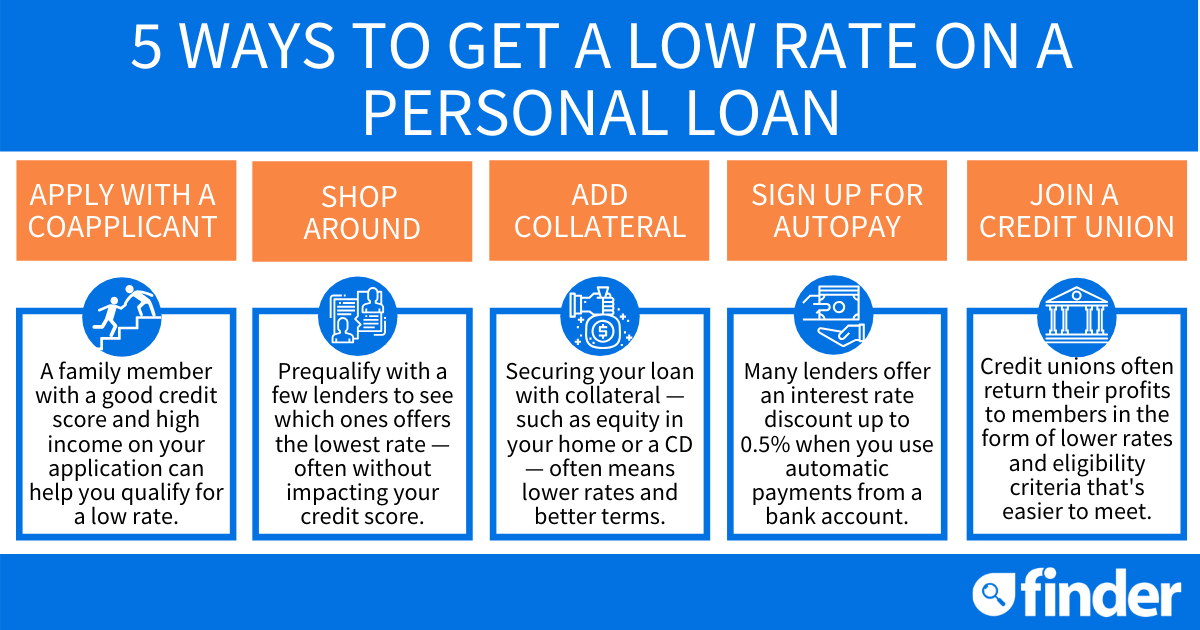The average personal loan interest rate was 11.14% in the first third of 2025, according to the Federal Reserve. In general, the interest rate you receive on a personal loan can range from a low 6% to a high 36%.
To score the lowest rates, you need excellent credit. Some experts identify 760 or higher as the sweet spot, but lenders can vary quite a bit on this point. Other aspects of your finances, the loan term and the amount you apply for also influence your rate.
We reviewed over 130 lenders before selecting those with the best personal loan rates. Comparing offers from multiple lenders can help you find the best deal available.
Interest rate vs. APR: What you need to know
Banks, credit unions and online lenders often interchangeably use the terms interest rate and annual percentage rate (APR) as if they’re the same thing. But there’s an important distinction. When you’re looking at the average interest rate on a personal loan, you’re seeing a number that doesn’t include regular fees.
An APR is the percentage of your loan balance that you pay in interest and fees over the course of a year. An APR only includes fees you’re required to pay if you take out a loan.
The most common fee associated with personal loans is an origination fee, which covers application costs. These tend to range from 1% to 10% of your loan amount and are either subtracted from your funds before you receive them or added to the balance you owe. If you take out a line of credit, your APR might also include annual fees.
However, your APR doesn’t include every possible fee that you could pay if you take out a loan. Late fees, prepayment penalties and nonsufficient funds (NSF) fees are all counted separately from the APR.
Personal loan interest rates
Personal loan interest rates depend on a range of factors, including your credit score and the type of financing you get.
Interest rates by credit score
Your credit score is one of the most important factors that lenders use to determine the interest rates you qualify for. The two main credit scoring models are FICO and VantageScore.
It’s not a perfect science, and FICO and VantageScore have some differences, but your credit scores can help you predict what interest rates you may receive when borrowing credit and help you choose a lender that can accommodate your credit rating.
| Credit score range | Average estimated interest rate (%)* |
|---|---|
| 720+ | 15.12% |
| 680-719 | 23.35% |
| 660-679 | 27.07% |
| 640-659 | 29.39% |
| 620-639 | 30.50% |
| 580-619 | 32.17% |
| 560-579 | 33.41% |
*Source: LendingTree consumer data, Q2 2025.
Borrowers with scores below 560 (or even higher in many cases) might not qualify for a lender that caps rates at 36% or less. However, some online lenders, like Upstart, for example, accept low credit scores and use alternative criteria to determine loan approval.
At the same time, many fair- and bad-credit borrowers struggle to qualify for a personal loan at all. In many cases, people with lower credit may turn to short-term loans like payday and installment loans. These loans can come with rates that top 300%.
Interest rates by financing type
Lenders tend to price distinct types of financing differently. Here’s how personal loan rates compare to credit cards and car loans from banks in 2025.
| Type of financing | Average rates at a bank |
|---|---|
| Personal loan (24 months) | 11.14% |
| Car loan (60 months) | 7.64% |
| Car loan (72 months) | 7.80% |
| Credit card | 21.39% |
Source: Federal Reserve Consumer Credit Statistics, Q3 2025
Personal loans vs. credit cards
As you can see from the Federal Reserve data, credit cards tend to have a higher average interest rate than personal loans. And, unlike credit cards, a personal loan has a set interest rate.
This means your monthly payments don’t fluctuate like they do with credit cards. You can also typically borrow more on average, even with a lower credit score.
But personal loans don’t come with some of the benefits of a credit card, such as flexible spending. This makes personal loans a bad choice for regular purchases, but a great choice for large expenses like home improvements or debt consolidation.
What is a good interest rate on a personal loan?
While the average personal loan interest rate was 11.14% as of August 2025, the average rate from the same quarter in 2024 was 12.33%, so rates have been trending down. In general, any interest rate under 12% for an unsecured loan is typically considered a reasonable interest rate.
But rates vary widely depending on your credit score. So, if you have good credit, you can expect an interest rate around the national average. If your credit is excellent, you might even qualify for a single-digit interest rate.
For those with poor credit, however, you can expect higher interest rates well above average. But if you have otherwise strong financials, some lenders may offer reasonable rates. You can also pledge collateral or use a cosigner on your loan to score a more competitive rate.
Average personal loan rates from top lenders
Most borrowers won’t qualify for the lowest advertised interest rate. So we considered the full range of rates lenders offer when coming up with this list.
We also didn’t include offers that are only available to a select few borrowers, such as community banks, local credit unions or invitation-only loans. And we limited the number of connection services — many share the same lowest rates because they work with similar partners.
The interest rate you receive depends on factors like your credit history, annual income, debt-to-income (DTI) ratio and overall financial picture. Prequalify with multiple lenders to find the best personal loan interest rate available to you.
Online lenders
| Lender | APR range | |
|---|---|---|
| Avant | 9.95%–35.99% | |
| Best Egg | 6.99%–35.99% | |
| Achieve | 8.99%–29.99% | |
| Laurel Road | 8.99%–23.25% | |
| LendingClub | 7.04%–35.99% | |
| LendingPoint | 7.99%–35.99% | |
| LightStream | 6.24% to 24.89% | |
| OneMain Financial | 18%–35.99% | |
| Happy Money | 7.95% to 29.99% | |
| Prosper | 8.99%–35.99% | |
| Rocket Loans | 8.01%–29.99% | |
| SoFi® | 8.74%–35.49% | |
| Upgrade | 7.74%–35.99% | |
| Upstart | 6.7%–35.99% | |
| LendingTree | 6.74%–35.99% |
Banks and credit unions
| Lender | APR range | |
|---|---|---|
| Alliant | Starting at 8.74% | |
| Citibank | 9.99%–19.49%* | |
| Discover | 7.99%–24.99% | |
| M&T Bank | 7.49%–13.69% | |
| Navy Federal Credit Union | 8.74%–18% | |
| PenFed | 7.99%–17.99% | |
| PNC Bank | 7.69%–26.44% | |
| TD Bank | 7.99%–23.99% | |
| U.S. Bank | 8.74%–24.99% | |
| USAA | ||
| Wells Fargo | 6.74%–26.49% |
Credit unions tend to have the lowest interest rates
Online lenders are fast, but they often charge more for the convenience — notable exceptions being SoFi and LightStream. A 36-month personal loan from a credit union had an average interest rate of 10.72% — lower than the national average for a 24-month personal loan, according to data from the National Credit Union Administration (NCUA). But banks had an average rate of 12.06%, a little higher than the national average.
In general, banks and credit unions can offer lower average interest rates because they often only work with current account holders. Plus, they typically have stricter requirements to qualify, further ensuring they get repaid.
That said, the average personal loan rate doesn’t differ significantly between banks and online lenders. You may be able to find lower personal loan rates with banks, but that doesn’t mean you’ll qualify.
Your best course of action is to compare personal loans from credit unions, banks and online lenders before you make a final decision.
8 factors that impact interest rate
The average personal loan interest rate is typically based on the requirements and conditions each lender sets. But there are a few common factors that influence rates with every personal loan lender.
- Credit score. The better your credit score and credit history, the more likely you are to qualify for a competitive interest rate below 10%.
- Loan term. A shorter loan term will have higher interest rates on average. But long loan terms, even with lower interest rates, often cost more overall.
- Discounts. Some lenders will offer a rate discount between 0.25% to 0.50% off your APR — that’s interest plus fees — when you sign up for autopay.
- Fees. Fees don’t directly impact your personal loan interest rate. But since an origination fee or application fee is worked into the APR, it will have an effect on your loan’s overall cost.
- Cosigner. A cosigner or coapplicant with good to excellent credit can help lower your interest rate by agreeing to take on shared responsibility for your loan.
- Secured loan vs unsecured loan. A secured loan will often have lower average interest rates than an unsecured loan. If you have a savings account, CD or other collateral, you may be able to use it to secure your loan and qualify for better terms.
- Higher income. Having a higher income is a good way to get a personal loan with a lower interest rate. But no worries if you don’t have the best income out there. Your debt-to-income ratio often matters more.
- DTI. Your debt-to-income ratio is the percentage of debt you have compared to your income. The less you’re already paying on loans and credit cards, the better your chances of getting a competitive rate.

How to compare APRs on a personal loan
These tips can help you make a more accurate comparison.
- Compare loans with the same terms to make an apples-to-apples comparison. A longer loan term increases the total cost of your loan.
- Don’t assume you’ll qualify for the lowest APR available if you’re comparing a range of rates. The average rate is usually higher.
- Consider the maximum APR if your credit score is below 670 — what lenders consider to be good credit.
- Ask your lender for an APR quote if a lender only advertises interest or fees.
- Read the fine print before you make a decision. Some lenders advertise rates with an autopay or relationship discount you might not qualify for.
- Prequalify with your top choices to compare the rates you might expect if you were to go through with the application. But make sure the lender offers a soft credit pull.
Compare lenders by more than only interest rate
Personal loan interest rates are one of the most important factors when it comes to how much you spend. However, they’re not the be-all, end-all when you’re looking to keep your monthly payment low and your costs down.
APR: A lower interest rate doesn’t mean much if the fees your lender charges make the APR higher than other personal loans you qualify for.
Discounts: Any discount to your interest rate or APR can significantly reduce your costs. Not all lenders offer discounts, so be on the lookout for those that do.
Fees: There are no-fee personal loans available. While it’s uncommon, lenders like SoFi won’t charge origination fees, prepayment fees or late fees. If you can’t qualify for a no-fee loan, look for lenders with the lowest fees.
Common personal loan fees include
- Origination fee. Some lenders charge an origination fee of around 1% to 10% of the loan amount at closing. They either deduct it from the funds you receive or add it to your loan balance. This is the only fee included in the APR.
- Late fee. Most lenders charge a flat late fee of around $15 to $35 or 5% of the payment due. Some also have a 15-day grace period before the late fee kicks in. This fee is not included in the APR.
- Nonsufficient funds fee. A nonsufficient funds fee (NSF), also known as a returned check or returned payment fee, will be charged if your payment bounces. Typically, it’s the same as a late fee, though sometimes it’s slightly higher. This fee is also not included in the APR.
Be aware of your monthly payment
Your monthly payments have the most immediate effect on your budget and are arguably the most important factor to consider when you apply for a loan. Monthly payments are based on the amount, rate and repayment term of your loan.
When you apply for a personal loan, you must show that you consistently have a high enough income and low enough debt payments to cover the monthly payment over the life of the loan.
Longer loan terms can give you lower monthly repayments, but that will increase your loan’s overall cost. Try to go for the shortest loan term you can afford to save on interest charges.
Calculate your monthly loan payment
Use our personal loan repayment calculator to compare monthly payments and the total cost of the loan based on different rates and loan terms.
Monthly Repayment Calculator
See how much you'll pay|
Your loan
|
|---|
| Loan amount |
|
$
|
| Loan terms (in years) |
|
|
| Interest rate |
|
%
|
Fill out the form and click on “Calculate” to see your estimated monthly payment.
or
Compare more lendersBased on your loan terms
| Principal | $ |
|---|---|
| Interest | $ |
| Total Cost | $ |
How do I calculate APR?
Follow these steps to calculate APR on a loan:
- Add up all fees and interest you would pay over the life of the loan.
- Divide that total by the loan amount to get the interest rate for the loan period.
- Divide by the loan term in years (for example, 14 days ÷ 365 ≈ 0.03836 years).
- Multiply by 100 to convert to a percentage.
Bottom line
The key to getting a competitive rate on a personal loan is comparing lenders. While almost every lender considers your credit score, each has its own method of evaluating your application that could result in a higher or lower rate.
You should compare low-interest personal loans to find some of the most competitive interest rates on the market.
Compare other products
We currently don't have that product, but here are others to consider:
How we picked theseWhat is the Finder Score?
The Finder Score crunches 6+ types of personal loans across 50+ lenders. It takes into account the product's interest rate, fees and features, as well as the type of loan eg investor, variable, fixed rate - this gives you a simple score out of 10.
Sources
Ask a question
More guides on Finder
-
Holiday Borrowing: What $1,000 Really Costs Across 5 Ways to Get Cash
The best way to finance the holidays might not be your credit card.
-
Small Loans: Borrow $20 or More Instantly
Cash advance apps and personal loan providers that offer small loans.
-
How to Get a $2,500 Personal Loan in 2025
Eligibility requirements and where to look for $2,500 loans.
-
How to Get a $4,000 Personal Loan in 2025
Where to shop for $4,000 loans and the requirements needed to qualify.
-
Personal Loans in Texas: Compare Options, How to Get One in 2025
Apply for a personal loan in Texas and get the funds you need.
-
Personal Loans in Pennsylvania (2025)
Apply for a personal loan in Pennsylvania and get the funds you need.
-
How to Get a $50,000 Personal Loan in 2025
Compare interest rates and loan terms of multiple providers to find the best offer for you.
-
How to Get a $1,500 Personal Loan in 2025
If you need cash for an emergency or to last you until payday, a $1,500 short-term loan could help — but with potential drawbacks.
-
How to Get a $1,000 Loan in 24 Hours in 2025
If you’re in need of $1,000 for an emergency, start a comparison of these bad credit lenders offering quick, unsecured $1,000 loans.
-
How to Get a $5,000 Personal Loan in 2025
Compare lenders that offer $5,000 loans for good, fair and bad credit.


